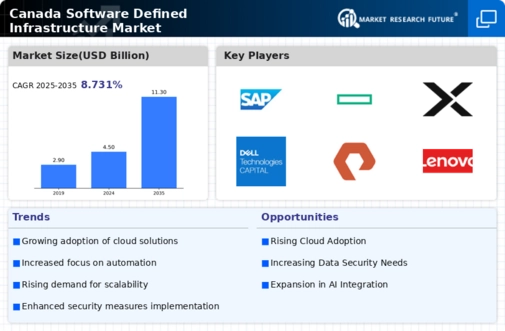The software defined-infrastructure market is currently characterized by a dynamic competitive landscape, driven by rapid technological advancements and increasing demand for flexible, scalable solutions. Key players such as VMware (US), Cisco (US), and Microsoft (US) are strategically positioned to leverage their extensive portfolios and innovative capabilities. VMware (US) focuses on enhancing its cloud infrastructure offerings, while Cisco (US) emphasizes network optimization and security solutions. Microsoft (US) is heavily investing in integrating AI capabilities into its infrastructure services, thereby reshaping the competitive environment through a blend of innovation and strategic partnerships.
In terms of business tactics, companies are increasingly localizing their operations to better serve regional markets, which appears to enhance supply chain efficiency. The market structure is moderately fragmented, with several players vying for market share. However, the collective influence of major companies like IBM (US) and Dell Technologies (US) is notable, as they continue to expand their service offerings and enhance customer engagement through tailored solutions.
In October 2025, VMware (US) announced a strategic partnership with a leading Canadian telecommunications provider to enhance its cloud services. This collaboration is expected to bolster VMware's presence in the region, allowing for improved service delivery and customer support. Such partnerships are crucial as they enable companies to tap into local expertise and infrastructure, thereby enhancing their competitive edge.
In September 2025, Cisco (US) unveiled a new suite of security-focused software defined solutions aimed at addressing the growing concerns around cybersecurity in cloud environments. This move not only strengthens Cisco's product offerings but also positions the company as a leader in securing software defined infrastructures, which is increasingly vital in today's digital landscape. The emphasis on security is likely to resonate well with enterprises seeking to mitigate risks associated with digital transformation.
In August 2025, Microsoft (US) launched an AI-driven analytics platform designed to optimize resource allocation in software defined environments. This initiative reflects Microsoft's commitment to integrating advanced technologies into its infrastructure solutions, potentially providing clients with enhanced operational efficiencies. The focus on AI integration is indicative of a broader trend within the market, where companies are leveraging cutting-edge technologies to differentiate their offerings.
As of November 2025, the competitive trends in the software defined-infrastructure market are increasingly defined by digitalization, sustainability, and the integration of AI technologies. Strategic alliances are playing a pivotal role in shaping the landscape, as companies seek to combine strengths to address complex customer needs. Looking ahead, competitive differentiation is likely to evolve from traditional price-based competition towards a focus on innovation, technological advancement, and supply chain reliability, suggesting a shift in how companies will position themselves in the market.






















Leave a Comment